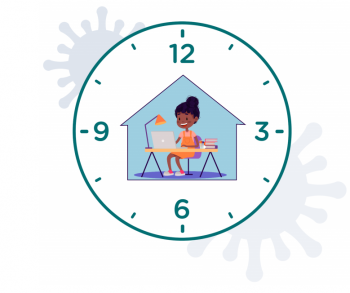We propose a simple indicator that marks as a clock the hours dedicated by each potential student to distance learning. This indicator integrates the issue of being enrolled or not, in addition to counting the days and hours in fact used for remote education. The average time spent for studies at home for the group of 6 to 15 years in August 2020 calculated from the microdata of the PNAD Covid was 2.37 hours per working day, lower than the minimum of 4 hours granted by the Law of the Basic Guidelines of Education (LBGE). The older is the student, the shorter the time he/she has devoted to remote study. Enrolled 16- and 17-year-olds are relatively more dedicated to remote education, but suffer from greater school dropout, and therefore present less time for school than children between 6 and 15 years. There is also a significant decrease in our estimates from the age of 18 onwards, with time for studies going from 2.34 to 0.95 hours/day. The main component that explains this difference is the reduction in school enrollment from 90% to 35%, a fact that had already been registered before the pandemic.
The lack of school activities perceived by students is more related to the inexistence of educational activities offered by the government and teachers than to the students' own demand for them: 13.5% of students aged 6 to 15 did not receive distance learning materials and only 2.88% did not use them for any other personal reason. The analysis by income class shows that the poorer the individual, the lower the enrollment rate in school, the lower the amount of exercises he/she received and, to make matters worse, the shorter the time he/she has dedicated to the exercises received. Consequently, the lower the indicator of time for studies at home. It is important to highlight that the poorest students are 633% more affected by the lack of school activities than the wealthiest students. We conclude that the inequality of educational opportunities and of educational performance will increase during the pandemic, reversing a historical trend.
The territorial analysis for the group aged between 6 and 15 years shows that Acre is at the bottom of the ranking among all 27 Units of the Federation, with less than half of the time for school than the leader Distrito Federal (1.29 and 2.96, respectively), which is also the leader in the ranking for students between 16 and 17 years old, followed by Piauí. When we look at the state’s capital cities, we observed that Teresina (Piauí) is in first place in the ranking with time for studies equal to 3 hours per working day, followed by Brasília (2.96). At the end of the ranking we have Rio Branco (1.43), Acre’s capital city. Therefore, even the leading states and their capital cities in the time for studies ranking were not able to reach the minimum school journey proposed by the LBGE. The lack of educational activities is mainly an issue linked to the lack of activities offered by government’s education offices, going from 2.09% of the students in Paraná without educational activities to 45.3% in Pará. In general, students from the North region in Brazil were also less involved with the few school activities they received, facts that suggest the existence of household infrastructure problems and other demand issues on the part of these students, in addition to a worsening in regional educational inequalities in Brazil after the pandemic. In short, the results suggest a loss in human capital accumulation and equality, with negative effects for the country in the long run.
All the research materials can be accessed on the FGV Social website.





